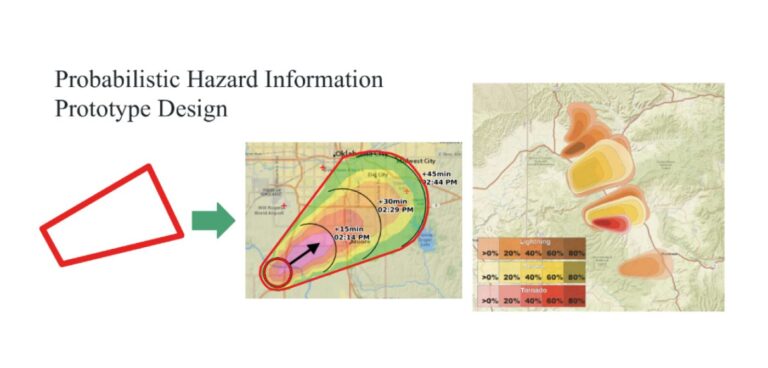NOAA has experimented with its Hazardous Weather Testbed (HWT), to stretch the boundaries of the traditional colored polygon on radar maps (used to represent severe weather) and create a forecasting tool that isn’t tied to a static shape.
The Hazardous Weather Testbed is a joint project of the National Weather Service (NWS) and NOAA National Severe Storms Laboratory (NSSL). During the annual HWT experiments, researchers work side-by-side with forecasters to test and evaluate emerging technologies and science, including forecast models and techniques. Together, they test products for future NWS adoption and operations. The goal of the team’s research was to develop methods for forecasters to create dynamic shapes that shift and morph with hazardous weather threats. This notification strategy would provide continuously refreshed information to enable people to make better decisions to protect themselves. The new approach to warnings is called Threats-in-Motion (TIM).
The research is led by the NOAA National Severe Storms Laboratory (NSSL) in collaboration with the Global Systems Lab and Meteorological Development Lab. Adrian Campbell and Rebecca Steeves, research associates at the Cooperative Institute for Severe and High-Impact Weather Research and Operations (CIWRO) at the University of Oklahoma, participated in the experiments. Campbell and Steeves, alongside other members of the research team, are developing software to improve the way forecasters issue warnings. For the HWT this spring, they were among those working virtually with forecasters in a controlled simulation to test the effectiveness of both the imaging and communication challenges of the new software.
Campbell said, “The traditional warning used by the NOAA National Weather Service is incredibly useful but has its limitations. Either you’re in a warning box or you’re not. As a member of the public, what do you do with that information? If you’re in the box, you’re supposed to take cover. If you’re out of the box, that’s the information you get. There are a few problems with that. You don’t know where the actual pattern is. You don’t know what the storm is doing. You don’t really know what direction it’s headed. You’re just given a binary decision.”
Steeves said, “In working with forecasters on the communication aspect of it, we’re learning we can add more customization into the tool for the display, so that’s one of our goals, to let them change how they can create graphics. That’s something we would want to improve upon. We’re incorporating forecaster feedback in as much as we can so we can keep the warning paradigm geared toward what they find useful.”
The researchers are also working on ways to enable forecasters to issue hazardous weather alerts that communicate the odds of severe weather impacting an area. In much the same way forecasters can predict a 40% chance of rain, for example, they could predict the probability of a particular storm producing a tornado using percentages – or probabilistic hazard information (PHI). Campbell said those odds can be calculated, but the challenge is how to communicate them clearly.
Campbell said, “We would like to compute this information about the probable path of these hazards like a tornado and throw it up on a map with a cone so that someone can say, ‘I’m at the edge of the cone, and it looks like I have a pretty good chance of being hit.’ Or, they could say, ‘I have a low chance of being hit, but I’m in a mobile home, so my risk threshold is a lot higher. I’m going to take action before a warning is issued.’ Better information allows people to make better decisions.”
Kodi Berry, NOAA NSSL research scientist who led this HWT collaboration, said, “A major component of this year’s experiments was strategizing how to meld two new emerging technologies. We investigated how the PHI interacts with and complements both the traditional and TIM warnings. The possibility of creating a streamlined new warning system to communicate detailed and meaningful information to the public could be life-saving. Without the entire team and the vast array of expertise represented, the experiment would have been impossible.”
Before returning to in-person HWT experiments in 2023, the research teams will analyze recorded data from this year’s experiments to make further improvements for the next phase of weather warning software.



